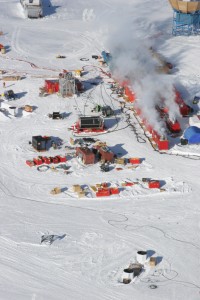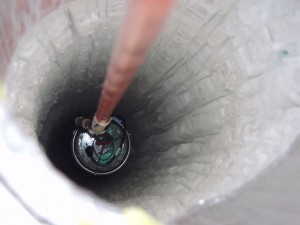
Although cosmic rays were discovered 100 years ago, their origin remains one of the most enduring mysteries in physics. Now, the IceCube Neutrino Observatory, a massive detector in Antarctica, is honing in on how the highest energy cosmic rays are produced.
“Although we have not discovered where cosmic rays come from, we have taken a major step toward ruling out one of the leading predictions,” said IceCube principal investigator and University of Wisconsin–Madison physics professor Francis Halzen.
Cosmic rays are electrically charged particles, such as protons, that strike Earth from all directions, with energies up to 100 million times higher than those created in man-made accelerators. The intense conditions needed to generate such energetic particles have focused physicists’ interest on two potential sources: the massive black holes at the centers of active galaxies, and the exploding fireballs observed by astronomers as gamma ray bursts, or GRBs.
IceCube is using neutrinos, which are believed to accompany cosmic ray production, to explore these theories. In a paper published in today’s issue of the journal Nature, the IceCube collaboration describes a search for neutrinos emitted from 300 gamma ray bursts observed, most recently in coincidence with the SWIFT and Fermi satellites, between May 2008 and April 2010. Surprisingly, they found none – a result that contradicts 15 years of predictions and challenges one of the two leading theories for the origin of the highest energy cosmic rays.
“The result of this neutrino search is significant because for the first time we have an instrument with sufficient sensitivity to open a new window on cosmic ray production and the interior processes of GRBs,” said IceCube spokesperson and University of Maryland physics professor Greg Sullivan. “The unexpected absence of neutrinos from GRBs has forced a re-evaluation of the theory for production of cosmic rays and neutrinos in a GRB fireball and possibly the theory that high energy cosmic rays are generated in fireballs.”
IceCube is a high energy neutrino telescope at the geographical South Pole in Antarctica, operated by a collaboration of 250 physicists and engineers from the USA, Germany, Sweden, Belgium, Switzerland, Japan, Canada, New Zealand, Australia and Barbados.

University of Alabama representatives in the IceCube collaboration are Drs. Dawn Williams and Patrick Toale, both assistant professors of physics in UA’s College of Arts and Sciences.
The lack of evidence of neutrinos formed by gamma ray bursts is startling to scientists, said Williams, who serves as the project’s calibration coordinator.
“This means that something we thought we knew about gamma ray bursts – and one of our most commonly held theories – does not look to be correct,” she said.
IceCube observes neutrinos by detecting the faint blue light produced in neutrino interactions in ice. Neutrinos are of a ghostly nature; they can easily travel through people, walls, or the planet Earth. To compensate for the antisocial nature of neutrinos and detect their rare interactions, IceCube is built on an enormous scale. One cubic kilometer of glacial ice, enough to fit the great pyramid of Giza 400 times, is instrumented with 5,160 optical sensors embedded up to 2.5 kilometers deep in the ice.
GRBs, the universe’s most powerful explosions, are usually first observed by satellites using X-rays and/or gamma rays. GRBs are seen about once per day, and are so bright that they can be seen from half way across the visible Universe. The explosions usually last only a few seconds, and during this brief time they can outshine everything else in the universe.
Improved theoretical understanding and more data from the compete IceCube detector will help scientists better understand the mystery of cosmic ray production. IceCube is currently collecting more data with the finalized, better calibrated, and better understood detector.
For more information about IceCube, visit www.icecube.wisc.edu.
Contact
Chris Bryant, UA Media Relations, 205/348-8323, cbryant@ur.ua.edu
Source
Dr. Dawn Williams, drwilliams3@ua.edu, 205/348-3770; Dr. Patrick Toale, 205/348-3041, patoale@ua.edu